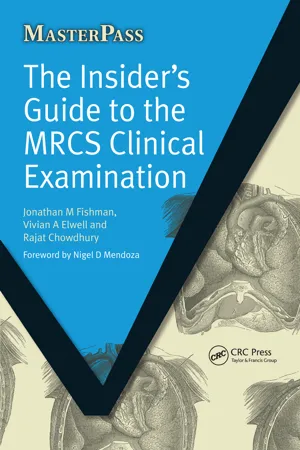
The Insider's Guide to the MRCS Clinical Examination
- 171 pages
- English
- ePUB (mobile friendly)
- Available on iOS & Android
The Insider's Guide to the MRCS Clinical Examination
About This Book
'The MRCS Clinical Examination is the final requirement to obtain the professional qualification for the Intercollegiate Membership of the Royal College of Surgeons. This Membership allows the transition from doctor to surgeon and a career in higher surgical training. This standardised clinical examination requires candidates to demonstrate their ability in examining patients, with effective and clear communication. 'The authors should be commended on producing a book that covers all clinical sections of the Examination, in such a concise, comprehensive and structured manner.This study guide will serve as your personal tutor working closely with you, prompting and providing pointers to improve your examination technique. It includes dozens of clinical scenarios, demonstrating how to examine the system and avoid common mistakes. In addition, the candidates can improve their communication skills, which is an integral part of this Examination. This book complements the "Insider Medical MRCS Clinical Course". It simulates the actual test conditions by providing sample cases and answers, coupling identification of weaknesses and strengths. This book will also prove to be extremely valuable for the new-style MRCS OSCE' - Nigel Mendoza in his Foreword.
Frequently asked questions
Information
SECTION A
The introduction
- ◗ permission
- ◗ position
- ◗ pain.
‘Good morning/afternoon. Thank you for coming along today. I’m one of the surgical doctors taking part in the examination today. May I examine you please?’
‘This patient has a toxic multinodular goitre, as evidenced by …’
‘This is consistent with a diagnosis of …’ or‘These findings support a diagnosis of …’
Superficial lesions: head, neck, breast and cutaneous lesions
Approach to any lump (or cutaneous lesion)
- Introduce yourself to the patient and wash your hands.
- Look. The rule of S’s:
- ◗ Site (distance in cm from nearest joint, anatomical triangle of neck, etc.).
- ◗ Size (diameter in cm).
- ◗ Shape (hemispherical, lobulated, etc.).
- ◗ Surface and smoothness – overlying punctum, smooth/ bosselated surface.
- ◗ Skin overlying – skin changes/colour, scars (with an overlying scar think of an implantation dermoid, pyogenic granuloma or recurrence following surgery).
- ◗ Surroundings – other lumps, satellite nodules.
- ◗ Special characteristics – e.g. moves with swallowing, protrusion of tongue.
- ◗ Edge – well-defined/ill-defined edge/border.
- Palpate. Tenderness – ask ‘Is it tender if I press it?’Temperature – use the back of the hand (which is more sensitive).Try to ascertain which layer the lump is in. (Can you pinch the skin overlying the lump, or can you move the skin over it? Does the lump move with the skin?)For skin lesions, is it flush with the skin, or is it raised?Tense/contract the underlying muscle:
- ◗ Test for mobility/fixity of the lump at rest in two orthogonal planes.
- ◗ Then ask the patient to contract the underlying muscle.
- ◗ Ask yourself whether the lump is more or less prominent.
- ◗ Ask yourself whether the lump is more or less mobile with the muscle contracted (in two planes).
Consistency – soft, firm, hard or bony hard. Fluctuance – in two planes at right angles to each other (Paget’s sign).Regional lymph node status (NEVER forget this!)
- retains mobility and is more prominent when the underlying muscle is contracted, the lump is superficial to muscle
- is more prominent but less mobile when the underlying muscle is contracted, the lump is attached to fascia or superficial surface of muscle
- is less mobile and less prominent when the underlying muscle is contracted, the lump is within muscle
- is less mobile and less prominent when the underlying muscle is contracted, the lump is deep to muscle.
- Percuss.
- Auscultate – bruits, bowel sounds.
- Surrounding neurovascular status – distal pulses, sensation.
- Ask the patient some questions/take a full history.
- Assess the impact of the condition on the patient’s life.
- Assess the patient’s fitness for surgery.
- Thank the patient and wash your hands.
- Summarise and offer your differential diagnosis.
Examination of the parotid lump
- Introduce yourself to the patient and wash your hands.
- Look at both sides and proceed as above. Look carefully for scars.
- Palpate – proceed as above. Ask whether the lump is tender before feeling it, and ask the patient to tense the underlying masseter muscle by requesting them to clench their jaw. Test for fixity. Define the characteristics of the lump, as you would for any other lump.
- Examine the regional lymph nodes. Look for evidence of scalp infection, or a primary carcinoma hidden in the scalp (if you suspect a pre-auricular lymph node).
- Check the oral cavity/oropharynx – use two tongue depressors and ask the patient to move their tongue to the right, to the left, place it on the roof of the mouth and then say Aaaaah, so that you can look at the palate and fauces.
- ◗ Exam...
Table of contents
- Cover Page
- Half Title Page
- Title Page
- Copyright Page
- Table of Contents
- Foreword
- About the authors
- Preface
- List of abbreviations
- Dedication
- Introducing the MRCS clinical exam: the Insider’s guide to success
- Section A
- Section B
- Index